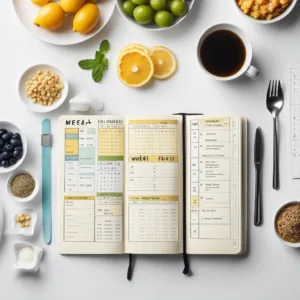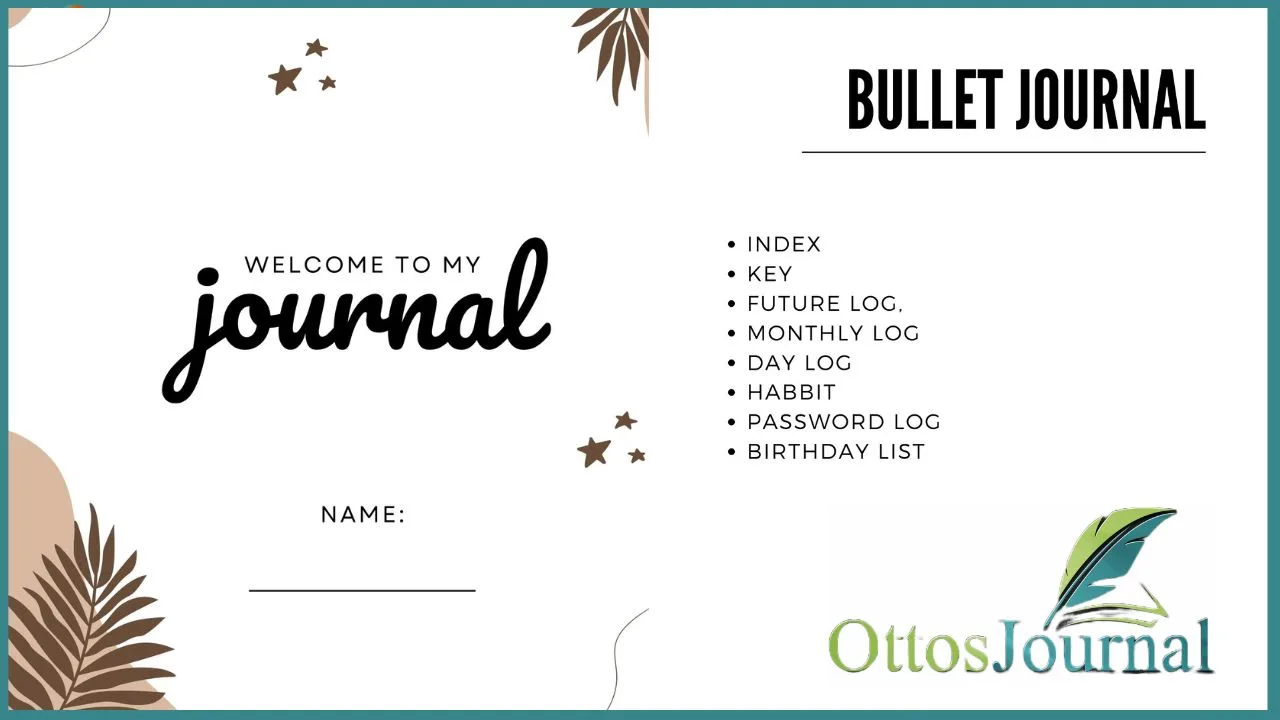Bullet journaling, also known as bujo, is a creative and versatile way to organize one’s life. It is a method of note-taking that allows individuals to track their daily tasks, goals, and habits. This system can be particularly helpful for students who need to manage their academic and personal lives effectively.
There are numerous bujo ideas that can benefit students. For example, creating a semester overview can be helpful in keeping track of important dates such as exams and project deadlines. Creating a study schedule can help students manage their time effectively and ensure that they are dedicating enough time to each subject. Other ideas include creating a habit tracker to monitor daily routines, setting goals for the semester, and using inspirational quotes to stay motivated. By using a bullet journal, students can keep their lives organized and stay on track to reach their goals.
Getting Started with Bujo
Bullet journaling is a simple and effective way to stay organized and productive. Students can use a bullet journal to keep track of assignments, deadlines, and personal goals. Here are some tips to help you get started with bujo:
Choosing Your Bujo Supplies
To start a bullet journal, you will need a notebook and a pen. Look for a notebook that has a sturdy cover and pages that can handle different types of pens and markers. Popular notebook brands for bullet journaling include Leuchtturm1917, Moleskine, and Rhodia.
In addition to a notebook and pen, you can also use washi tape, stickers, and other supplies to decorate your bullet journal and make it more personalized. However, keep in mind that these supplies are optional and not necessary for bullet journaling.
Understanding the Bujo Key and Index
The bullet journal system uses symbols and icons to represent tasks, events, and notes. These symbols are part of the bujo key, which is a legend that explains what each symbol means. For example, a bullet point represents a task, a circle represents an event, and a dash represents a note.
The bujo index is a table of contents that helps you find specific pages in your bullet journal. As you create new pages, you can add them to the index and label them with a page number. This makes it easy to flip to a specific page when you need to reference it.
Bujo ideas for students:
Here are 29 bujo ideas for students. This list will help you kickstart your semester:
Semester Overview
Begin by outlining the start and end dates of the semester, including breaks and holidays. Add major deadlines and exam periods. This high-level view helps with long-term planning and ensures you’re aware of the semester’s key dates.
Class Schedule
Create a weekly timetable with all your classes, including times and locations. Use color-coding for different subjects to make the schedule easy to read at a glance.
Assignment Tracker
List all your assignments with their due dates and status (not started, in progress, completed). Update it regularly to keep track of all your coursework.
Exam Timetable
Plot out your exam dates on a calendar or list, including times and locations. Prioritize your study time around this timetable to prepare effectively.
Study Planner
Break down your study sessions by subject and allocate time slots for each. Be realistic about how much time you need and can commit to each topic.
Grade Tracker
Set up a table to record your grades for each assignment and test. This can help you keep track of your academic progress and identify areas for improvement.
Reading List
Compile a list of all required and supplementary readings for your courses. Check them off as you complete them to stay on top of your coursework.
Project Deadlines
Note the due dates for all your projects. Break down larger projects into smaller tasks with their own deadlines to manage your workload.
Group Project Management
Dedicate a page for each group project, listing members, roles, deadlines, and meeting times. This helps coordinate efforts and keep everyone on track.
Research Topic Brainstorming
Create a mind map or list potential research topics. Use this space to jot down ideas and sources as you refine your research direction.
Essay Planning
Outline your essays with thesis statements, arguments, and evidence. Use bullet points or mind maps to organize your thoughts before writing.
Lecture Notes Organization
Designate sections for each course’s lecture notes. Use a consistent format to make it easier to review and study from later.
Professor Office Hours
Keep a list of your professors’ office hours and contact information. This ensures you know when and how to reach them for help or advice.
Scholarship Application Deadlines
Track scholarship opportunities with their requirements and deadlines. This can help you secure financial support for your studies.
Textbook Inventory
List your textbooks, including the edition and whether you need to buy or sell them. This can help manage costs and ensure you have the materials you need.
Club and Society Meetings
Record the meeting times and locations for any clubs or societies you’re involved in. This helps balance extracurriculars with your studies.
Campus Map and Important Locations
Sketch a map of your campus with key locations marked, like libraries, cafes, and study spaces. This can be a handy reference, especially if you’re new to the campus.
Study Group Sessions
Schedule your study group meetings, including subjects and goals for each session. This encourages collaborative learning and accountability.
Time Blocking for Productivity
Use time blocking to allocate specific hours for different activities, like studying, classes, and breaks. This can increase focus and efficiency.
Daily Routines
Outline your daily routines, including morning and evening rituals. This helps establish consistency and good habits.
Meal Planning for Students
Plan your meals for the week, including ingredients and prep time. This can help maintain a balanced diet and save money on eating out.
Budget and Expenses Tracker
Monitor your income and expenditures to manage your finances. Regular tracking can prevent overspending and help you save.
Fitness and Health Goals
Set fitness goals and track your progress. Include workout plans, dietary habits, and other health-related activities.
Personal Goal Setting
Write down your personal goals and the steps needed to achieve them. Regularly review and update your progress.
Inspirational Quotes for Motivation
Collect quotes that inspire you. Refer to them when you need a motivational boost.
Mindfulness and Self-Care Routines
Plan and track your mindfulness practices and self-care activities. This can improve mental health and academic performance.
Habit Tracking
Choose habits you want to develop and track your daily adherence. This visual reminder can help reinforce positive behaviors.
Social Life and Event Planner
Keep track of social events and outings. This ensures you make time for relaxation and socializing.
Career Planning and Job Search
List career goals, potential job opportunities, and steps for achieving them. This can guide your professional development efforts.

Bujo Layouts for Students
Bullet journaling is an excellent way for students to stay organized and productive. By creating a bullet journal, students can keep track of their assignments, deadlines, and schedules. Here are some bujo layouts that students can use to stay on top of their school work.
Setting Up Your Monthly and Weekly Spreads
The monthly spread is a great way to get an overview of the entire month. Students can use this spread to keep track of important dates such as exams, project deadlines, and school events. To set up a monthly spread, students can create a table with the days of the month and add important events and deadlines to each day.
The weekly spread is an excellent way to plan out the week ahead. Students can use this spread to break down their tasks and assignments into manageable chunks. To set up a weekly spread, students can create a table with the days of the week and add their tasks and assignments to each day.
Designing Effective Daily Logs
The daily log is where students can keep track of their tasks and assignments for the day. To design an effective daily log, students can create a table with three columns: one for the task or assignment, one for the due date or deadline, and one for the status of the task or assignment.
Students can use symbols such as bullets, circles, and squares to indicate the status of each task or assignment. For example, a filled-in circle could indicate that the task or assignment is complete, while an empty circle could indicate that the task or assignment is still in progress.
Bujo journaling is an excellent way for students to stay organized and productive. By using monthly spreads, weekly spreads, and daily logs, students can keep track of their assignments, deadlines, and schedules. With a little bit of creativity and design, students can create a bullet journal that is both functional and aesthetically pleasing.
Academic Planning and Tracking
Keeping track of academic responsibilities is crucial to academic success. Bullet journaling can help students manage their assignments, deadlines, and study schedules. Here are some ideas for academic planning and tracking using a bullet journal:
Managing Assignments and Deadlines
One of the most important aspects of academic planning is managing assignments and deadlines. A bullet journal can help students keep track of their due dates and ensure they are meeting their deadlines.
Students can create a spread that includes a list of all their assignments and their due dates. They can also color-code their assignments based on their priority level. This will help them prioritize their work and ensure they are meeting their deadlines.
Creating Study and Class Schedules
Another important aspect of academic planning is creating study and class schedules. A bullet journal can help students create a schedule that works for them. Students can create a spread that includes their class schedule and their study schedule.
They can also create a time-blocking spread that breaks down their day into specific study blocks. This will help them stay on track and ensure they are dedicating enough time to their studies.
Bujo journaling can be an effective tool for academic planning and tracking. By creating spreads that help them manage their assignments, deadlines, and study schedules, students can ensure they are meeting their academic responsibilities and achieving academic success.
Enhancing Student Productivity
Incorporating Habit and Study Trackers
Bullet journaling can be an effective tool for students to track their habits and study progress. By creating habit and study trackers, students can monitor their daily routines and identify areas for improvement. Habit trackers can be used to monitor activities such as exercise, reading, and self-care. Study trackers can be used to monitor study time, assignments, and deadlines.
Using a habit tracker can help students establish a routine and stay focused on their goals. By tracking their progress, students can identify patterns in their behavior and adjust their habits accordingly. Study trackers can help students stay on top of their assignments and deadlines, ensuring that they stay organized and focused.
Organizing Tasks with To-Do Lists
To-do lists can be a powerful tool for students to stay organized and manage their time effectively. By creating a to-do list, students can prioritize their tasks and ensure that they complete them in a timely manner. To-do lists can be created on a daily, weekly, or monthly basis, depending on the student’s needs.
When creating a to-do list, it’s important to be specific and realistic. Students should break down larger tasks into smaller, more manageable ones. This can help them stay motivated and avoid feeling overwhelmed. Students can use symbols or colors to indicate the level of priority for each task.
Incorporating habit and study trackers, as well as organizing tasks with to-do lists, can help students enhance their productivity and achieve their goals. By staying focused and organized, students can make the most of their time and achieve academic success.
Personal Growth and Well-being
Tracking Health and Self-Care Routines
Bullet journaling can be an excellent tool for tracking health and self-care routines. By creating a dedicated spread for tracking things like exercise, water intake, and meditation, students can make sure they are taking care of themselves and staying on top of their personal health goals. By tracking things like mood and sleep patterns, students can gain insight into their mental health and make adjustments if necessary.
One effective way to track health and self-care routines is by using a habit tracker. This can be as simple as a table with a list of habits to track and checkboxes to mark off each day when the habit is completed. By keeping a habit tracker in their bullet journal, students can easily monitor their progress and identify areas where they may need to improve.
Reflecting with Bullet Journal Collections
In addition to tracking health and self-care routines, bullet journaling can also be a powerful tool for reflection and personal growth. By creating collections that encourage reflection and introspection, students can gain a deeper understanding of themselves and their personal goals.
One popular collection for reflection is the gratitude log. This involves taking a few minutes each day to write down things that the student is grateful for. By focusing on the positive aspects of their life, students can improve their mood and overall well-being.
Another useful collection for reflection is the brain dump. This involves taking a few minutes each day to write down any thoughts, ideas, or concerns that are weighing on the student’s mind. By getting these thoughts out of their head and onto paper, students can reduce stress and improve their mental clarity.
Bullet journaling can be an effective tool for promoting personal growth and well-being. By tracking health and self-care routines and creating collections for reflection, students can gain insight into themselves and make positive changes in their personal lives.
Frequently Asked Questions
How can bullet journaling benefit a student’s academic life?
Bullet journaling can provide numerous benefits for students in their academic life. It can help students stay organized, manage their time effectively, and keep track of their goals and progress. By using a bullet journal, students can create a personalized system that works for their individual needs, and they can easily adjust and modify their system as needed. Bullet journaling can help reduce stress and anxiety by providing a creative outlet and a sense of control over one’s life.
What are some must-have pages for a student’s bullet journal?
There are several pages that are essential for a student’s bullet journal, including a monthly calendar, a daily or weekly planner, a study schedule, a grade tracker, and a goal-setting page. These pages can help students stay on top of their assignments, schedule, and academic progress. Students may find it helpful to include pages for note-taking, brainstorming, and project planning.
How can a student effectively use a bullet journal to track their studies and homework?
To effectively use a bullet journal to track studies and homework, students should first create a system that works for them. This may involve using different symbols or colors to indicate different types of assignments, or creating a specific layout for each subject. Students should also make sure to regularly update their journal with new assignments and deadlines, and review their progress regularly to ensure they are staying on track.
What are creative ways to incorporate a study tracker into a bullet journal?
There are many creative ways to incorporate a study tracker into a bullet journal, including using different symbols or colors to indicate different types of studying or assignments, creating a visual representation of progress, or using a habit tracker to monitor daily study habits. Students may also find it helpful to include motivational quotes or images to help keep them motivated.
Can bullet journaling help manage ADHD for students, and if so, how?
Bullet journaling can be a helpful tool for students with ADHD, as it provides a structured system for organization and planning. By breaking down tasks into smaller, manageable steps, students can reduce feelings of overwhelm and improve their focus and productivity. The creative aspect of bullet journaling can provide a sense of enjoyment and engagement that may help students with ADHD stay motivated and on task.
What essential items do students need to start a bullet journal for school purposes?
To start a bullet journal for school purposes, students will need a notebook or journal, pens or markers, and a ruler. While additional supplies such as stickers or washi tape can be fun to use, they are not essential. Students should choose a notebook that is durable and has enough pages to last the entire school year, and pens or markers that do not bleed through the paper.



